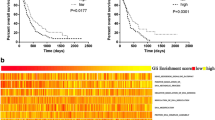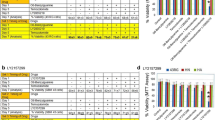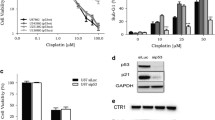Abstract
This study investigated the effects of β-elemene + methoxyamine, a DNA base-excision repair inhibitor, on the inhibition of glioma growth. We treated C6 and SHG44 glioma cells with β-elemene and methoxyamine individually or in combinations, and subsequently analyzed cellular survivals by MTT assay. Comet assay, γ-H2AX focus formation assay and Western-blot were performed to investigate whether the observed cytotoxicity was associates with DNA damages. Finally, a xenograft tumor model was established in nude mice with C6 cells to analyze in vivo tumor inhibition effects of β-elemene, which was followed by determination of the expression of anti-apoptotic protein Bcl-2 via immunohistochemistry staining. Results showed that β-elemene could significantly inhibit the growth of glioma cells in a dose- and time-dependent manner. The combination of methoxyamine with β-elemene could result in a greater extent of DNA injuries in vitro. Furthermore, in vivo tumors exhibited a marked shrinkage in volume in β-elemene + methoxyamine treatment group. Immunohistochemistry analysis of the tumor tissues showed a distinctive decrease in Bcl-2 staining in β-elemene (56 %) and β-elemene + methoxyamine (36 %) groups when compared with the negative control (77 %). In conclusion, β-elemene exhibits a significant cytotoxic effect against glioma cells both in vitro and in vivo, which is likely to be mediated by its potential to damage tumor cell DNA and activate apoptotic pathway. Such growth inhibition effect of β-elemene could be potentiated by methoxyamine co-administration. Therefore, a combination of the two agents as a novel chemotherapeutic option for glioma merits further investigations.





Similar content being viewed by others
References
Sanson M (2008) Editorial review: targets for glioma treatment: from bench to bedside. Curr Opin Oncol 20:650–651
Wang XS, Yang W, Tao SJ et al (2006) Effect of delta-elemene on Hela cell lines by apoptosis induction. Yakugaku Zasshi 126:979–990
Xie CY, Yang W, Li M et al (2009) Cell apoptosis induced by delta-elemene in colorectal adenocarcinoma cells via a mitochondrial-mediated pathway. Yakugaku Zasshi 129:1403–1413
Xu L, Tao S, Wang X et al (2006) The synthesis and anti-proliferative effects of beta-elemene derivatives with mTOR inhibition activity. Bioorg Med Chem 14:5351–5356
Rui D, Xiaoyan C, Taixiang W et al (2007) Elemene for the treatment of lung cancer. Cochrane Database Syst Rev 17(4):CD006054
Sun Y, Liu G, Zhang Y et al (2009) Synthesis and in vitro anti-proliferative activity of beta-elemene monosubstituted derivatives in HeLa cells mediated through arrest of cell cycle at the G1 phase. Bioorg Med Chem 17:1118–1124
Tao L, Zhou L, Zheng L et al (2006) Elemene displays anti-cancer ability on laryngeal cancer cells in vitro and in vivo. Cancer Chemother Pharmacol 58:24–34
Wang G, Li X, Huang F et al (2005) Antitumor effect of beta-elemene in non-small-cell lung cancer cells is mediated via induction of cell cycle arrest and apoptotic cell death. Cell Mol Life Sci 62:881–893
Wang K, Li Z, Chen Y et al (2005) The pharmacokinetics of a novel anti-tumor agent, beta-elemene, in Sprague-Dawley rats. Biopharm Drug Dispos 26:301–307
Li QQ, Wang G, Zhang M et al (2009) Beta-Elemene, a novel plant-derived antineoplastic agent, increases cisplatin chemosensitivity of lung tumor cells by triggering apoptosis. Oncol Rep 22:161–170
Mathews LA, Cabarcas SM, Farrar WL (2011) DNA repair: the culprit for tumor-initiating cell survival? Cancer Metastasis Rev 30:185–197
Klein TJ, Glazer PM (2010) The tumor microenvironment and DNA repair. Semin Radiat Oncol 20:282–287
Higgins GS, Prevo R, Lee YF et al (2010) A small interfering RNA screen of genes involved in DNA repair identifies tumor-specific radiosensitization by POLQ knockdown. Cancer Res 70:2984–2993
Seo Y, Kinsella TJ (2009) Essential role of DNA base excision repair on survival in an acidic tumor microenvironment. Cancer Res 69:7285–7293
Zhang J, Stevens MF, Bradshaw TD (2012) Temozolomide: mechanisms of action, repair and resistance. Curr Mol Pharmacol 5:102–114
Leonetti C, Biroccio A, Graziani G et al (2012) Targeted therapy for brain tumours: role of PARP inhibitors. Curr Cancer Drug Targets 12:218–236
Goellner EM, Svilar D, Almeida KH et al (2012) Targeting DNA polymerase ss for therapeutic intervention. Curr Mol Pharmacol 5:68–87
Tawbi HA, Villaruz L, Tarhini A et al (2011) Inhibition of DNA repair with MGMT pseudosubstrates: phase I study of lomeguatrib in combination with dacarbazine in patients with advanced melanoma and other solid tumours. Br J Cancer 105:773–777
Bulgar AD, Weeks LD, Miao Y et al (2012) Removal of uracil by uracil DNA glycosylase limits pemetrexed cytotoxicity: overriding the limit with methoxyamine to inhibit base excision repair. Cell Death Dis 3:e252
Berridge MV, Tan AS (1993) Characterization of the cellular reduction of 3-(4,5-dimethylthiazol-2-yl)-2,5-diphenyltetrazolium bromide (MTT): subcellular localization, substrate dependence, and involvement of mitochondrial electron transport in MTT reduction. Arch Biochem Biophys 303:474–482
Olive PL, Banath JP (2006) The comet assay: a method to measure DNA damage in individual cells. Nat Protoc 1:23–29
Muslimovic A, Ismail IH, Gao Y et al (2008) An optimized method for measurement of gamma-H2AX in blood mononuclear and cultured cells. Nat Protoc 3:1187–1193
Barth RF, Kaur B (2009) Rat brain tumor models in experimental neuro-oncology: the C6, 9L, T9, RG2, F98, BT4C, RT-2 and CNS-1 gliomas. J Neurooncol 94:299–312
Stupp R, Hegi ME, Mason WP et al (2009) Effects of radiotherapy with concomitant and adjuvant temozolomide versus radiotherapy alone on survival in glioblastoma in a randomised phase III study: 5-year analysis of the EORTC-NCIC trial. Lancet Oncol 10:459–466
Kelland L (2007) The resurgence of platinum-based cancer chemotherapy. Nat Rev Cancer 7:573–584
Perry J, Laperriere N, Zuraw L et al (2007) Adjuvant chemotherapy for adults with malignant glioma: a systematic review. Can J Neurol Sci 34:402–410
Pang BC, Wan WH, Lee CK et al (2007) The role of surgery in high-grade glioma–is surgical resection justified? a review of the current knowledge. Ann Acad Med Singapore 36:358–363
Tsao MN, Mehta MP, Whelan TJ et al (2005) The American Society for Therapeutic Radiology and Oncology (ASTRO) evidence-based review of the role of radiosurgery for malignant glioma. Int J Radiat Oncol Biol Phys 63:47–55
Neyns B, Sadones J, Chaskis C et al (2005) The role of chemotherapy in the treatment of low-grade glioma. A review of the literature. Acta Neurol Belg 105:137–143
Chen W, Lu Y, Wu J et al (2010) Beta-elemene inhibits melanoma growth and metastasis via suppressing vascular endothelial growth factor-mediated angiogenesis. Cancer Chemother Pharmacol 67(4):799–808
Li QQ, Wang G, Zhang M et al (2009) beta-Elemene, a novel plant-derived antineoplastic agent, increases cisplatin chemosensitivity of lung tumor cells by triggering apoptosis. Oncol Rep 22:161–170
Li X, Wang G, Zhao J et al (2005) Antiproliferative effect of beta-elemene in chemoresistant ovarian carcinoma cells is mediated through arrest of the cell cycle at the G2-M phase. Cell Mol Life Sci 62:894–904
Wang Y, Fang MY (2006) Effect of ginseng saponin, arsenic trioxide, beta-elemene combined with CTX on telomere-telomerase system in K562 cell line. Zhongguo Shi Yan Xue Ye Xue Za Zhi 14:1089–1095
Wu XS, Xie T, Lin J et al (2009) An investigation of the ability of elemene to pass through the blood-brain barrier and its effect on brain carcinomas. J Pharm Pharmacol 61:1653–1656
Yao YQ, Ding X, Jia YC et al (2008) Anti-tumor effect of beta-elemene in glioblastoma cells depends on p38 MAPK activation. Cancer Lett 264:127–134
Humlova Z (2002) Protooncogene bcl-2 in process of apoptosis. Review article. Sb Lek 103:419–425
Yuan J, Gu ZL, Chou WH et al (1999) Elemene induces apoptosis and regulates expression of bcl-2 protein in human leukemia K562 cells. Zhongguo Yao Li Xue Bao 20:103–106
Zhang H, Xu F, Xie T et al (2012) Beta-elemene induces glioma cell apoptosis by downregulating survivin and its interaction with hepatitis B X-interacting protein. Oncol Rep 28:2083–2090
Kao GD, Jiang Z, Fernandes AM et al (2007) Inhibition of phosphatidylinositol-3-OH kinase/Akt signaling impairs DNA repair in glioblastoma cells following ionizing radiation. J Biol Chem 282:21206–21212
Zhu T, Zhao Y, Zhang J et al (2011) ss-Elemene inhibits proliferation of human glioblastoma cells and causes cell-cycle G0/G1 arrest via mutually compensatory activation of MKK3 and MKK6. Int J Oncol 38:419–426
Zhu T, Xu Y, Dong B et al (2011) Beta-elemene inhibits proliferation of human glioblastoma cells through the activation of glia maturation factor beta and induces sensitization to cisplatin. Oncol Rep 26:405–413
Zhao YS, Zhu TZ, Chen YW et al (2012) Beta-elemene inhibits Hsp90/Raf-1 molecular complex inducing apoptosis of glioblastoma cells. J Neurooncol 107:307–314
Riemenschneider MJ, Reifenberger G (2009) Novel insights into the pathogenesis of gliomas based on large-scale molecular profiling approaches. Curr Opin Neurol 22:619–624
Quillien V, Vauleon E, Saikali S et al (2011) MGMT analysis in gliomas. Bull Cancer 98:291–303
Dinnes J, Cave C, Huang S et al (2002) A rapid and systematic review of the effectiveness of temozolomide for the treatment of recurrent malignant glioma. Br J Cancer 86:501–505
Dinnes J, Cave C, Huang S et al (2001) The effectiveness and cost-effectiveness of temozolomide for the treatment of recurrent malignant glioma: a rapid and systematic review. Health Technol Assess 5:1–73
Zhao J, Li QQ, Zou B et al (2007) In vitro combination characterization of the new anticancer plant drug beta-elemene with taxanes against human lung carcinoma. Int J Oncol 31:241–252
Acknowledgments
We would like to thank Dr. Yi-duo Hu from the Department of Cancer Biology, Dana-Farber Cancer Institute and Department of Genetics, Harvard Medical School for his kind help in preparing this manuscript. We also would like to thank associate professor Xiu-yang Li, from the Department of Public Health, Zhejiang University School of Medicine, for her expertise in statistical analysis.
Conflict of interest
The authors have declared that no conflict of interest exist.
Funding
This study is supported in part by grant from the Zhejiang Provincial Administration of Traditional Chinese Medicine (Grant 2007CA060 and 2009CA044) and Zhejiang Provincial Natural Science Foundation (No. Y2091211).
Author information
Authors and Affiliations
Corresponding author
Electronic supplementary material
Below is the link to the electronic supplementary material.
Rights and permissions
About this article
Cite this article
Zhu, Y., Hu, J., Shen, F. et al. The cytotoxic effect of β-elemene against malignant glioma is enhanced by base-excision repair inhibitor methoxyamine. J Neurooncol 113, 375–384 (2013). https://doi.org/10.1007/s11060-013-1136-0
Received:
Accepted:
Published:
Issue Date:
DOI: https://doi.org/10.1007/s11060-013-1136-0




